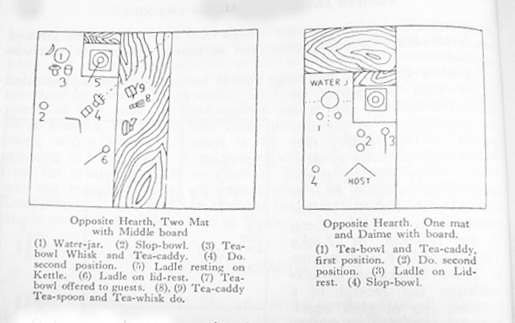FLOWER ARRANGEMENTS FOR CHA-NO-YU
茶花
Flowers arranged according to the conventional styles of the various schools such as Ikenobo, Enshu, etc., are not suited for the Tea-room.
茶室の花は池坊や遠州などの華道の花とはちがいます。
It seems that the very formal types of arrangement now called the Enshu and Sekishu schools are much later than these masters, and only derive from later pupils of their schools of Tea, if indeed they have any connection with them at all.
遠州流や石州流などの華道による花のいけ方は、実は、茶人のそれよりも後に生まれたものなので茶人は習うことはないのです。
The earlier Tea Masters only taught the simple natural style called Nage-iri (Thrown-in flower).
茶人によるいけ花とは、「投げ入り」といい簡素な方法なのです。
Only a single blossom is placed naturally in the vase, or at most one or two more may on occasions be added.
花を一輪自然に花瓶に飾ります、増やしても一二輪です。

The height of the flower above the vase is only one-third of the height of the latter, compared with the one and a half times of the ordinary arrangements.
花瓶から出る花の高さは花瓶の三分の一ぐらいで、1対0.5の比率が一般的です。
At evening Cha-no-yu the flower vase is used first and the Kakemono afterwards.
夜の茶事では花が先で次に掛け物です。
Only in a room larger than four-and half mats may both be set out together.
四畳半以上の部屋の場合に一所に飾ります。
At an Evening Tea colored flowers should never be used for they cannot be seen properly.
夜の茶事において、色のついた花は正式ではありません。
Yellow is the most undesirable since it is the most invisible.
黄色の花は言語道断です。
White flowers should be used at night if any are needed.
何も足さず、白い花が使われます。
It is related of Tokugawa Hidetada, the second Shogun, who was fond of Cha-no-yu, that he was once presented with a peony that had blossomed in the winter as a rarity.
このことは二代将軍、徳川秀忠の時に決まりました。彼は茶の湯をしていて、珍しく冬にシャクヤクの花が咲きましたので、それを茶花にしようと思いました。
He looked at it and praised its beauty, but ordered that it should be thrown away and not put in a vase, because unseasonable things are unnatural and should never be displayed.
とても綺麗ででしたが、その花は飾られることはありませんでした。理由は、季節感のないものは飾ってはいけないという茶の湯の規範に触れたためです。
Chajin prefer bamboo flower vases to either pottery or bronze ones.
花瓶は竹が好みで、陶器、銅なども使われます。
Their preference is in that order.
彼らの好みはこのことで分かるでしょう。
The first was made by Rikyu for Hideyoshi when on the Odawara campaign against Hojo in 1590.
竹の花瓶がはじめて使われたのは、秀吉の小田原へ北条家征伐の時に利休が同行した時です。
Hojo is said to have given Hideyoshi a present of three pieces of bamboo in return for one of three bale of rice which the Taiko had sent to his castle as a joke.
秀吉が北条方へ米の包み三個をジョークで送った返事として、北条方は竹を三つ送り返して来ました。
Of these Rikyu made three flower vases, one single, one two-storied and one flute-shaped.
利休はそれを、筒花入れ、二つ口、笛型とそれぞれ花入れを作ったのです。
The first was named Enjoji, because, like the bell of that temple, it was cracked.
最初の筒花入れは寺の鐘に似ていることからEnjojiと名づけられました。そしてそれは欠けました。
This fact seems to have given it the greatest reputation of the three.
三個の内この花瓶が評判になりました。
It passed to Sen Sotan and once when some one commented to him on a slight leak from the crack that moistened the Tko, he replied that this was its life.
この花瓶はSen Sotanへ引き継がれ、欠けているので床に水が漏れてしまうのでですが、彼は何度もこの花瓶を使いました。
But it would have been reprehensible in any other.
しかし、非難する人はいなかったということです。
These three are the Great Meibutsu of bamboo vases and Takahashi informs us that the Shakuhachi or Flute-shaped one was sold at the Akaboshi sale in 1918 for \8,600.
これらの竹の花入れは大名物として珍重され、1918年に一つが8600円で売買されたと言うことです。
Should the guest be asked by the host to arrange flowers in the Tea-room, as for instance when there is one guest only, so that he will not be lonely while the host is preparing the utensils in the Mizuya, he should always request the latter to pour in the water, for this is considered a very delicate operation, since it varies according to the flower and the vase, while to put the finishing touch is the prerogative of the host.
茶室において、一人の客の時にのみ亭主は花の飾りをその客に依頼します。水屋にて茶の湯の準備中、一人手持ちぶたさにしないためと思われますが、水を差し心配りをします。その後、最後に亭主が花入れに触れ、これが亭主の特権と言えるかもしれません。
INTRODUCTION-1 TITLE CONTENTS